Page 18 of 425
3
Seats / 3-2
Seat belts / 3-12
Child restraint system / 3-26
Air bag - supplemental restraint system / 3-34
Safety features of your vehicle
Page 19 of 425
Safety features of your vehicle
2 3
Driver’s seat
(1) Forward and backward
(2) Seatback angle
(3) Seat cushion height
(4) Headrest
(5) Armrest*
Front passenger’s seat
(6) Forward and backward
(7) Seatback angle
(8) Headrest
Rear seat
(9) Headrest*
(10) Seatback folding*
*: if equipped
SEATS
ORB032001R
WARNING- Loose objects
Loose objects in the driver’s foot
area could interfere with the opera-
tion of the foot pedals, possibly
causing an accident. Do not place
anything under the front seats.
Page 21 of 425
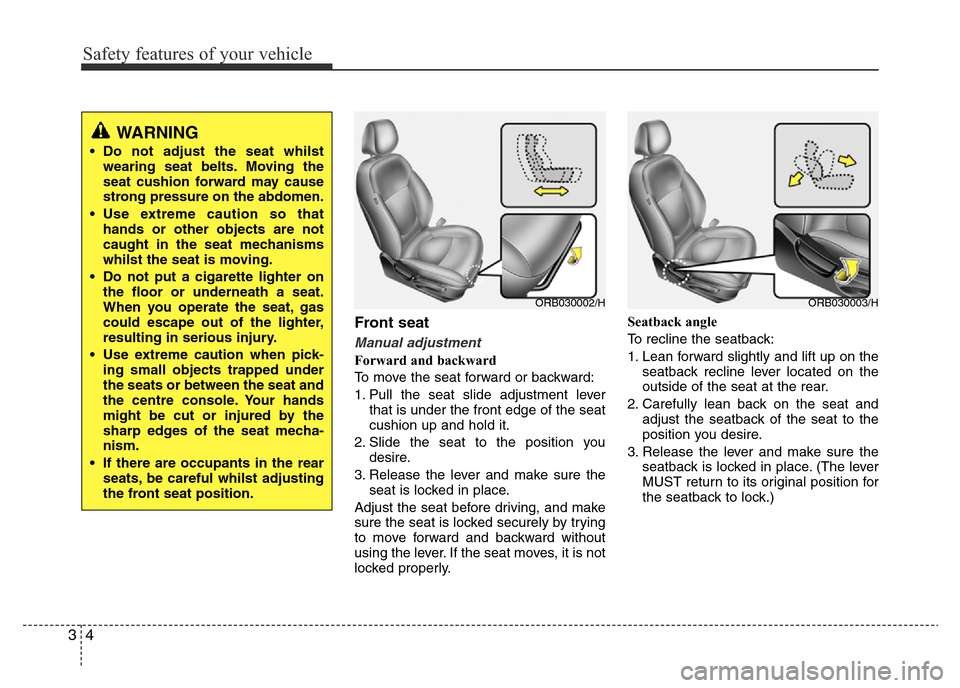
Safety features of your vehicle
4 3
Front seat
Manual adjustment
Forward and backward
To move the seat forward or backward:
1. Pull the seat slide adjustment lever
that is under the front edge of the seat
cushion up and hold it.
2. Slide the seat to the position you
desire.
3. Release the lever and make sure the
seat is locked in place.
Adjust the seat before driving, and make
sure the seat is locked securely by trying
to move forward and backward without
using the lever. If the seat moves, it is not
locked properly.Seatback angle
To recline the seatback:
1. Lean forward slightly and lift up on the
seatback recline lever located on the
outside of the seat at the rear.
2. Carefully lean back on the seat and
adjust the seatback of the seat to the
position you desire.
3. Release the lever and make sure the
seatback is locked in place. (The lever
MUST return to its original position for
the seatback to lock.)
ORB030003/HORB030002/H
WARNING
• Do not adjust the seat whilst
wearing seat belts. Moving the
seat cushion forward may cause
strong pressure on the abdomen.
• Use extreme caution so that
hands or other objects are not
caught in the seat mechanisms
whilst the seat is moving.
• Do not put a cigarette lighter on
the floor or underneath a seat.
When you operate the seat, gas
could escape out of the lighter,
resulting in serious injury.
• Use extreme caution when pick-
ing small objects trapped under
the seats or between the seat and
the centre console. Your hands
might be cut or injured by the
sharp edges of the seat mecha-
nism.
• If there are occupants in the rear
seats, be careful whilst adjusting
the front seat position.
Page 22 of 425
35
Safety features of your vehicle
Seat cushion height (for driver’s seat)
To change the height of the seat cushion,
push the lever that is located on the out-
side of the seat cushion upwards or
downwards.
• To lower the seat cushion, push the
lever down several times.
• To raise the seat cushion, pull the lever
up several times.Armrest (for driver’s seat)
(if equipped)
To use the armrest, swing down the arm-
rest to the lowest position.
Headrest
The driver's and front passenger's seats
are equipped with a headrest for the
occupant's safety and comfort.
The headrest not only provides comfort
for the driver and front passenger, but
also helps to protect the head and neck
in the event of a collision.
ORB030004/HORB030006/HOMG038400
Page 25 of 425
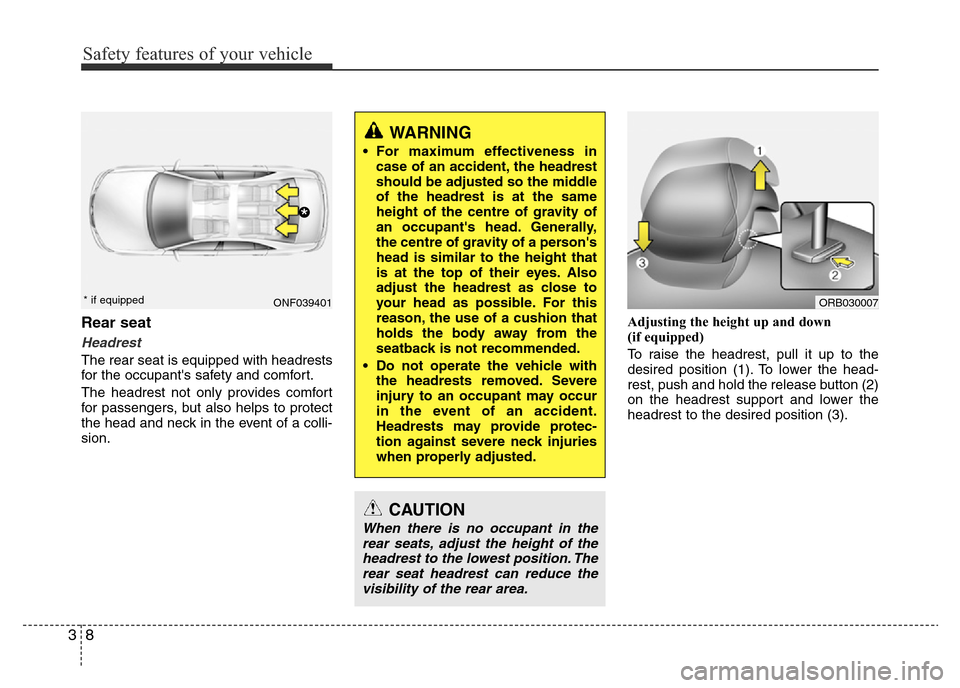
Safety features of your vehicle
8 3
Rear seat
Headrest
The rear seat is equipped with headrests
for the occupant's safety and comfort.
The headrest not only provides comfort
for passengers, but also helps to protect
the head and neck in the event of a colli-
sion.Adjusting the height up and down
(if equipped)
To raise the headrest, pull it up to the
desired position (1). To lower the head-
rest, push and hold the release button (2)
on the headrest support and lower the
headrest to the desired position (3).
ORB030007
WARNING
• For maximum effectiveness in
case of an accident, the headrest
should be adjusted so the middle
of the headrest is at the same
height of the centre of gravity of
an occupant's head. Generally,
the centre of gravity of a person's
head is similar to the height that
is at the top of their eyes. Also
adjust the headrest as close to
your head as possible. For this
reason, the use of a cushion that
holds the body away from the
seatback is not recommended.
• Do not operate the vehicle with
the headrests removed. Severe
injury to an occupant may occur
in the event of an accident.
Headrests may provide protec-
tion against severe neck injuries
when properly adjusted.
CAUTION
When there is no occupant in the
rear seats, adjust the height of the
headrest to the lowest position. The
rear seat headrest can reduce the
visibility of the rear area.
ONF039401
*
* if equipped
Page 26 of 425
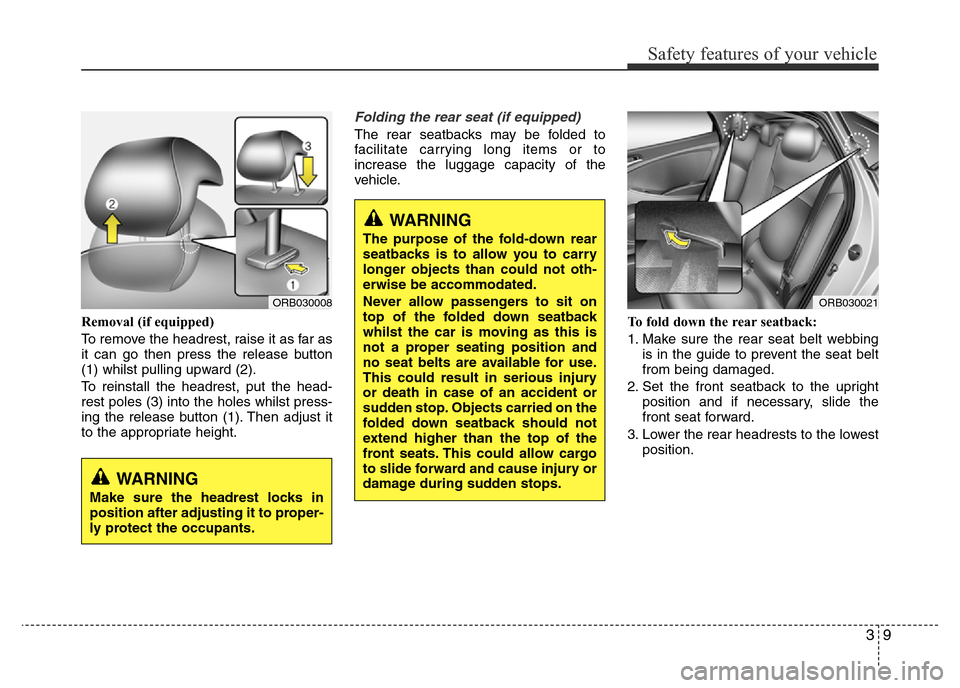
39
Safety features of your vehicle
Removal (if equipped)
To remove the headrest, raise it as far as
it can go then press the release button
(1) whilst pulling upward (2).
To reinstall the headrest, put the head-
rest poles (3) into the holes whilst press-
ing the release button (1). Then adjust it
to the appropriate height.
Folding the rear seat (if equipped)
The rear seatbacks may be folded to
facilitate carrying long items or to
increase the luggage capacity of the
vehicle.
To fold down the rear seatback:
1. Make sure the rear seat belt webbing
is in the guide to prevent the seat belt
from being damaged.
2. Set the front seatback to the upright
position and if necessary, slide the
front seat forward.
3. Lower the rear headrests to the lowest
position.
WARNING
Make sure the headrest locks in
position after adjusting it to proper-
ly protect the occupants.
ORB030008ORB030021
WARNING
The purpose of the fold-down rear
seatbacks is to allow you to carry
longer objects than could not oth-
erwise be accommodated.
Never allow passengers to sit on
top of the folded down seatback
whilst the car is moving as this is
not a proper seating position and
no seat belts are available for use.
This could result in serious injury
or death in case of an accident or
sudden stop. Objects carried on the
folded down seatback should not
extend higher than the top of the
front seats. This could allow cargo
to slide forward and cause injury or
damage during sudden stops.
Page 28 of 425
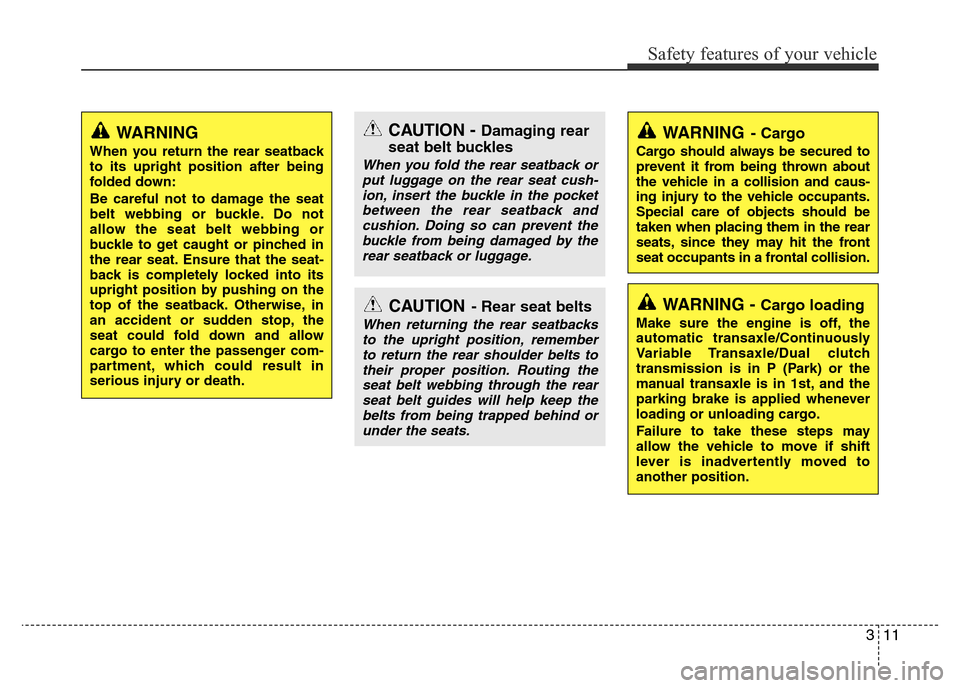
311
Safety features of your vehicle
WARNING
When you return the rear seatback
to its upright position after being
folded down:
Be careful not to damage the seat
belt webbing or buckle. Do not
allow the seat belt webbing or
buckle to get caught or pinched in
the rear seat. Ensure that the seat-
back is completely locked into its
upright position by pushing on the
top of the seatback. Otherwise, in
an accident or sudden stop, the
seat could fold down and allow
cargo to enter the passenger com-
partment, which could result in
serious injury or death.
WARNING- Cargo
Cargo should always be secured to
prevent it from being thrown about
the vehicle in a collision and caus-
ing injury to the vehicle occupants.
Special care of objects should be
taken when placing them in the rear
seats, since they may hit the front
seat occupants in a frontal collision.
WARNING - Cargo loading
Make sure the engine is off, the
automatic transaxle/Continuously
Variable Transaxle/Dual clutch
transmission is in P (Park) or the
manual transaxle is in 1st, and the
parking brake is applied whenever
loading or unloading cargo.
Failure to take these steps may
allow the vehicle to move if shift
lever is inadvertently moved to
another position.
CAUTION- Rear seat belts
When returning the rear seatbacks
to the upright position, remember
to return the rear shoulder belts to
their proper position. Routing the
seat belt webbing through the rear
seat belt guides will help keep the
belts from being trapped behind or
under the seats.
CAUTION - Damaging rear
seat belt buckles
When you fold the rear seatback or
put luggage on the rear seat cush-
ion, insert the buckle in the pocket
between the rear seatback and
cushion. Doing so can prevent the
buckle from being damaged by the
rear seatback or luggage.
Page 38 of 425
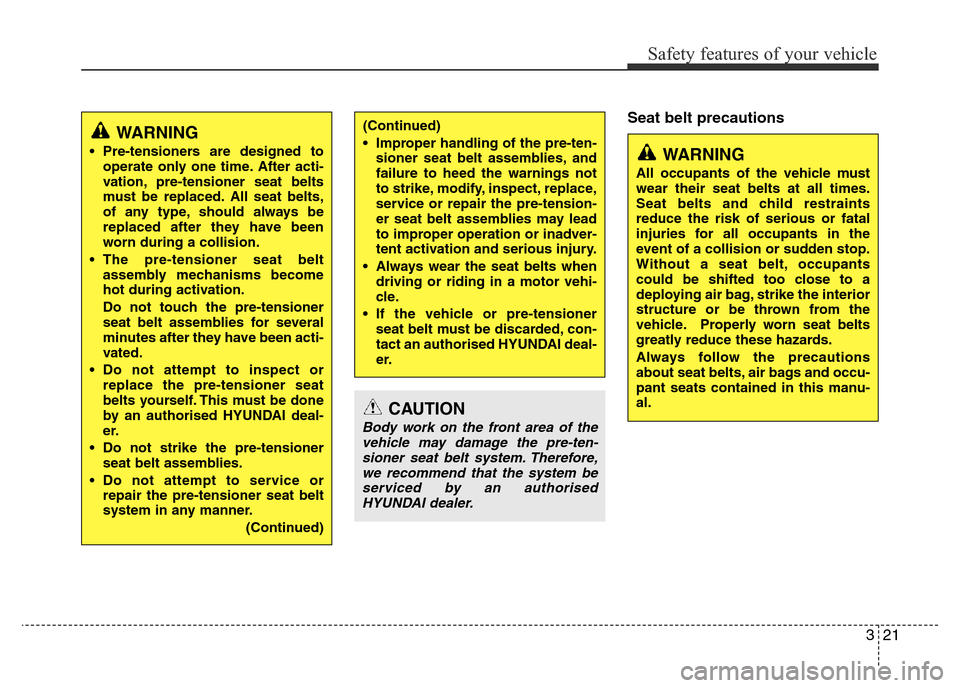
321
Safety features of your vehicle
Seat belt precautions
WARNING
• Pre-tensioners are designed to
operate only one time. After acti-
vation, pre-tensioner seat belts
must be replaced. All seat belts,
of any type, should always be
replaced after they have been
worn during a collision.
• The pre-tensioner seat belt
assembly mechanisms become
hot during activation.
Do not touch the pre-tensioner
seat belt assemblies for several
minutes after they have been acti-
vated.
• Do not attempt to inspect or
replace the pre-tensioner seat
belts yourself. This must be done
by an authorised HYUNDAI deal-
er.
• Do not strike the pre-tensioner
seat belt assemblies.
• Do not attempt to service or
repair the pre-tensioner seat belt
system in any manner.
(Continued)
(Continued)
• Improper handling of the pre-ten-
sioner seat belt assemblies, and
failure to heed the warnings not
to strike, modify, inspect, replace,
service or repair the pre-tension-
er seat belt assemblies may lead
to improper operation or inadver-
tent activation and serious injury.
• Always wear the seat belts when
driving or riding in a motor vehi-
cle.
• If the vehicle or pre-tensioner
seat belt must be discarded, con-
tact an authorised HYUNDAI deal-
er.
WARNING
All occupants of the vehicle must
wear their seat belts at all times.
Seat belts and child restraints
reduce the risk of serious or fatal
injuries for all occupants in the
event of a collision or sudden stop.
Without a seat belt, occupants
could be shifted too close to a
deploying air bag, strike the interior
structure or be thrown from the
vehicle. Properly worn seat belts
greatly reduce these hazards.
Always follow the precautions
about seat belts, air bags and occu-
pant seats contained in this manu-
al.
CAUTION
Body work on the front area of the
vehicle may damage the pre-ten-
sioner seat belt system. Therefore,
we recommend that the system be
serviced by an authorised
HYUNDAI dealer.